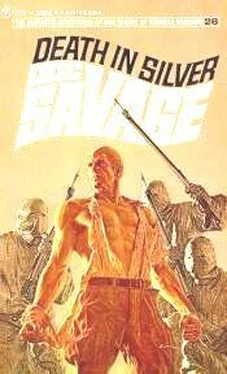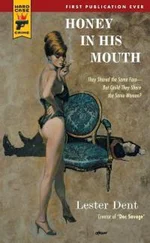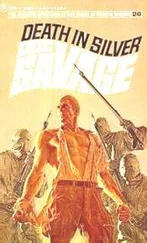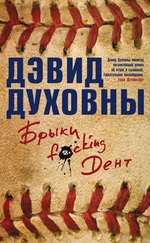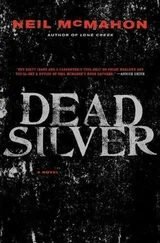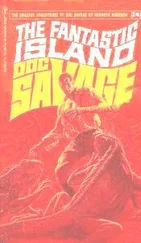Debris fell to the sidewalk with a great uproar. 3 parked cars — fortunately unoccupied — were crushed and a prowling taxicab was partially wrecked. The driver of the hack — slightly cut and bruised — got out and ran, squawling that there had been an earthquake.
Following the fall of the debris, there was a brittle jangling of dropping glass all over the neighborhood for windows had been blown out by the blast. Numerous people were cut; others had narrow escapes.
Then came several moments of almost complete silence. The quiet was so complete that the droning of an airplane over the nearby river could be heard. Then as the plane swept away, there was the sound of a motorboat, also on the river.
The presence of the plane and the motorboat on the river at that particular instant came to the attention of a number of persons and was later to become a fact of significance.
The tension following the explosion snapped. Women screeched and had hysterics. More stoic souls peered up in the fog and observed the yawning hole in the side of the skyscraper where the private office of Paine L. Winthrop had been. Policemen came running and ambulance sirens wailed. Bedlam reigned.
The building housing Paine L. Winthrop's shipping company — the Seven Seas — was not the most imposing in the Wall Street sector. But it narrowly missed that designation. Penthouses ornamented the tops of most of the skyscrapers in the district. And this particular one was no exception.
The penthouse on this building was a pretentious affair with numerous glass walls which afforded the occupant full sunlight. Most of the glass had been shattered by the blast below. In fact, it was a miracle that the whole structure had not gone down with a resultant vast loss of life!
One of the penthouse rooms contained many workbenches. These supported racks holding innumerable test tubes, retorts, microscopes, mixing trays, pestles and bottled chemicals. That the benches had supported this array would be more correct for most of the stuff was now on the floor. Several small chemical fires had started.
A remarkable-looking man was picking himself up from the mess of glass and liquids. He jumped up-and-down and emitted a roar for he had been slightly burned by a vial of acid.
The roar and the way the fellow bounced about gave the impression of a great, angry ape. The man's appearance did little to detract from the impression. He had practically no forehead. His thick, muscle-gnarled arms were longer than his legs. And his skin was leathery and covered with bristles which resembled rusty nails. His mouth was so unnaturally large that it looked as if there had been an accident in the assembling of his pleasantly ugly face.
"Habeas!" the apish man bellowed.
A pigcame galloping into view, squealing excitedly. It was an almost incredibly grotesque specimen of the porker family, as homely in his way as was the man who had called him. The shote had long, doglike legs, a scrawny body, an inquisitive snout, and ears almost large enough to serve as wings.
"Dang it, Habeas," the homely chemist grinned. "I was afraid that dude lawyer had thrown a grenade at you."
Someone seemed to be trying to open a near-by door. Loud kicks sounded, wood crunched, and the door fell inward.
The man who came through was slender, waspish, and attired to the height of sartorial perfection. He had a high forehead and the mobile mouth of an orator. In one hand, he gripped a thin black cane which was slightly separated at a joint near the handle, thus disclosing the object to be a sword cane with a razor-sharp blade.
The well-dressed man glared at the homely chemist, his expression that of a gentleman who had just found a toad on his breakfast table.
"Monk, I always did know you would blow us up with some of your idiotical chemical experiments!" he snapped.
This was nothing if not libel. The apish man 'Monk' was Lieutenant Colonel Andrew Blodgett Mayfair, conceded by those who knew to be one of the greatest of living chemists. His head — which did not look as if it had room for a thimbleful of brains — harbored a fabulous amount of chemical and electrochemical lore.
Monk glared at the dapper newcomer.
"The shyster lawyer heard from," he growled.
That was another libel. The dressy gentleman was Brigadier General Theodore Marley Brooks — better known as 'Ham' — one of the most astute lawyers ever to get his sheepskin from Harvard.
A strange pair, these two! They were always together. Yet no one could remember either one having spoken a civil word to the other. Those who knew, however, could cite a number of instances when each had risked his life to save the other.
Men far-famed in their professions, both of them. Yet they were known to the comers of the Earth for another reason — known as 2 members of a group of 5 who were assistants to a man who was probably the most famed adventurer of all time.
Monk and Ham were aides of Doc Savage— the Man of Bronze , the "man of mystery", the being of fabulous accomplishments — who was almost a legend to the general public, but who was the synonym for terror and justice to those who preyed upon their fellow men.
- — — — — — — — — — — — — — — — — — — — — — — — — —
Ham flourished his sword cane. "What was that? That quake?"
"Search me," said Monk whose voice — in repose — was remarkably small and querulously child-like.
Seizing a fire extinguisher, Monk went to work on the chemical blazes. He resented this damage to his laboratory for it was one of the most complete in existence, exceeded only by those maintained by the Man of Bronze — Doc Savage — who was himself a greater chemist than Monk.
Habeas Corpus — Monk's pet pig — backed away from the flames; saw he was getting near Ham; and hastily shied off. Habeas and Ham did not get along together. Ham had repeatedly threatened to make breakfast bacon out of Habeas.
The fires doused, Monk cast aside the extinguisher.
"Let's find out what happened," he said.
"A good idea coming from a strange source," Ham stated unkindly, and they went out. They left the pig Habeas behind.
The elevators were not operating — probably due to the damage wrought by the blast — and they had to walk down. It did not take them long to reach the scene of the detonation.
They were efficient, these 2 men accustomed to scenes of violence through their long association with Doc Savage. Doc seemed to exist always in the shadow of peril and destruction.
Without delay, they went to work to ascertain the cause of the explosion. And there, they ran up against a profound puzzle as well as a gruesome scene.
Paine L. Winthrop was dead. No doubt of that as it was necessary for the ambulance surgeons to assemble the scattered parts of his body on a stretcher before it could be carried away.
Several of the Seven Seas office employees had been injured. A broken arm — received by a stenographer as she was knocked over her desk — was the most serious. Others were only lacerated and bruised.
Monk and Ham put quick inquiries about the cause of the blast. No one could give a reply of value except Paine L. Winthrop's head clerk, who was quite sure there had been no bomb since she had left the private office only shortly before the arrival of her boss.
Before Monk and Ham could locate fragments of whatever had caused the detonation, a swarm of policemen and newspaper reporters arrived. The officers herded everyone to an office one floor below, it having been decided that the skyscraper was in no danger of falling.
Читать дальше
